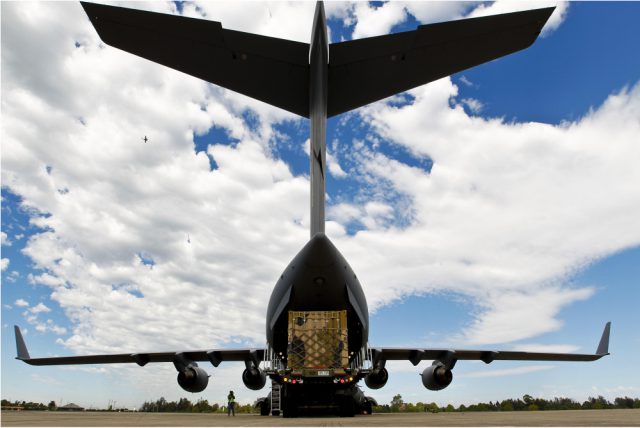The WPS agenda must also be responsive to natural disasters
Posted By Elisabeth Buchan on March 16, 2017 @ 11:00

This article is part of a series on ‘Women, Peace and Security’ that The Strategist is publishing in recognition of International Women’s Day 2017.
When Foreign Minister, Julie Bishop, and her Labor counterpart, Penny Wong, visited Samoa, Solomon Islands and Vanuatu in December, emergency response was at the forefront of the agenda. Disaster response is a key priority of regional humanitarian action; most crises in the Indo-Pacific [1] were the result of natural disasters, and from 2005-2014 natural disasters affected 1.4 billion people [2] in the Asia Pacific region, 80% of the global total.
But there is another key statistic here: the impact on women [3]. Women are more likely to die [4] during disasters, and incidence of sexual and gender-based violence spikes in post-disaster settings [5]. So any strategy for women, peace and security (WPS) in the region must incorporate humanitarian response.
WPS is founded in UNSC Resolution 1325 and targets the disproportionate and unique harm suffered by women and girls during and after times of conflict. Australia formalised its commitment to Resolution 1325 and its subsequent resolutions—collectively the WPS Agenda—through the establishment of a WPS National Action Plan (NAP) in 2012. (Read Susan Hutchinson’s assessment of the first NAP here [6]). The 2015 UN global study [7] on the implementation of UNSCR 1325 identified women’s vulnerability in humanitarian-settings as an emerging theme in WPS. Recognising that ‘principles of gender equality in humanitarian assistance are not limited to conflict-affected settings but equally relevant to natural disasters’, the study provided the impetus to expand WPS beyond the traditional parameters of armed-conflict. The Independent Interim Review [8] of Australia’s NAP raised the possibility of expanding WPS action to include humanitarian response.
Disaster relief should be treated as a WPS issue for two reasons.
First, the disruption caused by natural disasters is analogous to armed conflict, and the security issues facing women in the two contexts overlap, because:
- the breakdown of rule of law exposes women to increased violence, including gender-based violence
- the destruction of key protective infrastructure like homes, police stations and shelters leaves women vulnerable to exploitation and abuse, including human trafficking
- food and water shortages force women and girls to travel further and in less secure circumstances to gather basic resources and
- the disruption of essential services, especially reproductive and maternal services, threatens women’s health.
Second, there’s a growing movement toward a gendered approach to disaster relief [9]. In 2012, the UN Commission on the Status of Women adopted resolution 56/2 [10], which highlights the disproportionate impact of natural disasters on women, and the social and economic [11] factors that underscore women’s vulnerability. In March this year Australia co-hosted the high-level event ‘Achieving Gender Equality and Women’s Empowerment in Humanitarian Action through the World Humanitarian Summit’. Ensuring that humanitarian programming is gender responsive was one of 32 core commitments [12] developed ahead of the Summit. That attention has inspired a wealth of policy papers on improving gender awareness in humanitarian response in the Asia Pacific (see here [13], here [14] and here [15]). The Australian Civil Military Centre has published a comprehensive paper [9] on incorporating gender issues into Australia’s natural disaster response.
The two agendas are mutually reinforcing. They both promote a gendered approach to peace and security during and, after a violent disruption, many of the prescribed relief efforts in disaster and armed conflict are convergent.
In the field, Australia’s Humanitarian Assistance and Disaster Relief (HADR) effort following Cyclone Winston, Operation Fiji Assist [16], is a prime example of the benefits of incorporating the WPS agenda into civil-military operations, including disaster response. A military gender adviser was included as part of the deployment of about 650 ADF personnel, to advise the Joint Task Force headquarters on incorporating WPS considerations [17] into planning. Aid donations [18] from ADF personnel were targeted at women and girls, including items such as sanitary products, nappies and school books.
Australia is a prominent contributor [1] to disaster relief. In the past two years, the government provided humanitarian assistance to regional neighbours including Indonesia [19] (Aceh earthquake), Vanuatu [20] (Cyclone Pam), the Philippines [21] (Typhoon Melor) and Fiji (Cyclone Winston). From July 2015 to April 2016 alone, Australia responded to 20 crises [1]. The 2016 Defence White Paper [22] (DWP) noted that humanitarian disasters have the potential to cause instability in our immediate region. It’s in Australia’s national interest to maintain a leading role in the Indo-Pacific to support humanitarian and disaster relief operations. Integrating gender perspectives into those operations will be essential to their overall effectiveness.
When it comes to including women’s security in natural disasters, some of the policy guidance is already there. Gender equality and women’s empowerment is a thematic priority of DFAT’s 2016 Humanitarian Strategy [23], and the DWP affirms the ADF’s ongoing support for WPS. Within the next two years DFAT will develop a new Foreign Policy White Paper [24] and commence work on the second NAP on WPS. These are real opportunities to improve WPS outcomes where natural disasters occur.
Article printed from The Strategist: https://www.aspistrategist.org.au
URL to article: https://www.aspistrategist.org.au/wps-agenda-must-also-responsive-natural-disasters/
URLs in this post:
[1] crises in the Indo-Pacific: http://dfat.gov.au/aid/topics/investment-priorities/building-resilience/humanitarian-preparedness-and-response/Pages/humanitarian-prepraredness-and-response.aspx
[2] 1.4 billion people: https://drive.google.com/file/d/0B9AqTbpsu1gTSmpFc2d0U0lpeFk/view?pli=1
[3] the impact on women: https://thinkprogress.org/5-reasons-natural-disasters-are-worse-for-women-60fcf429b111#.b7cnv2ofg
[4] more likely to die: http://www.smh.com.au/national/women-more-likely-to-die-in-natural-disasters-20151120-gl420j.html
[5] spikes in post-disaster settings: https://consultations.worldhumanitariansummit.org/bitcache/a013ad0b3de01c192588653dd4138280fbdcbc69?vid=575816&disposition=inline&op=view
[6] here: https://www.aspistrategist.org.au/australias-efforts-women-peace-security-require-360-degree-monitoring/
[7] 2015 UN global study: http://peacewomen.org/sites/default/files/UNW-GLOBAL-STUDY-1325-2015%20(1).pdf
[8] Independent Interim Review: https://www.dpmc.gov.au/sites/default/files/publications/nap-interim-review-report.pdf
[9] gendered approach to disaster relief: https://www.acmc.gov.au/wp-content/uploads/2014/09/Gendered-Crises-Gendered-Responses.pdf
[10] resolution 56/2: http://www.wcdrr.org/wcdrr-data/uploads/854/Commission%20on%20the%20Status%20of%20Women_56th%20session.pdf
[11] social and economic: http://www.unisdr.org/files/48152_disasterandgenderstatistics.pdf
[12] 32 core commitments: http://www.agendaforhumanity.org/aboutthecommitments
[13] here: http://apwld.org/wp-content/uploads/2015/03/Climate-change-Natural-disasters-Conflict.pdf
[14] here: http://www.undp.org/content/dam/undp/library/gender/Gender%20and%20Environment/PB3-AP-Gender-and-disaster-risk-reduction.pdf
[15] here: http://reliefweb.int/sites/reliefweb.int/files/resources/integrating_gender_into_humanitarian_action-good_practices_from_asia_pacific_3.pdf
[16] Operation Fiji Assist: http://www.australiandefence.com.au/news/operation-fiji-assist-widens-lhd-deployed
[17] incorporating WPS considerations: http://www.doncio.navy.mil/CHIPS/ArticleDetails.aspx?ID=8114
[18] Aid donations: http://news.navy.gov.au/en/Mar2016/Operations/2802/Donations-directly-support-Fijian-women.htm
[19] Indonesia: http://foreignminister.gov.au/releases/Pages/2016/jb_mr_161210.aspx?w=tb1CaGpkPX%2FlS0K%2Bg9ZKEg%3D%3D
[20] Vanuatu: http://foreignminister.gov.au/releases/Pages/2015/jb_mr_150523.aspx?w=tb1CaGpkPX%2FlS0K%2Bg9ZKEg%3D%3D
[21] the Philippines: http://foreignminister.gov.au/releases/Pages/2015/jb_mr_150102.aspx?w=tb1CaGpkPX%2FlS0K%2Bg9ZKEg%3D%3D
[22] 2016 Defence White Paper: http://www.defence.gov.au/whitepaper/Docs/2016-Defence-White-Paper.pdf
[23] Humanitarian Strategy: http://dfat.gov.au/about-us/publications/Documents/dfat-humanitarian-strategy.pdf
[24] Foreign Policy White Paper: http://dfat.gov.au/whitepaper/index.html
Click here to print.